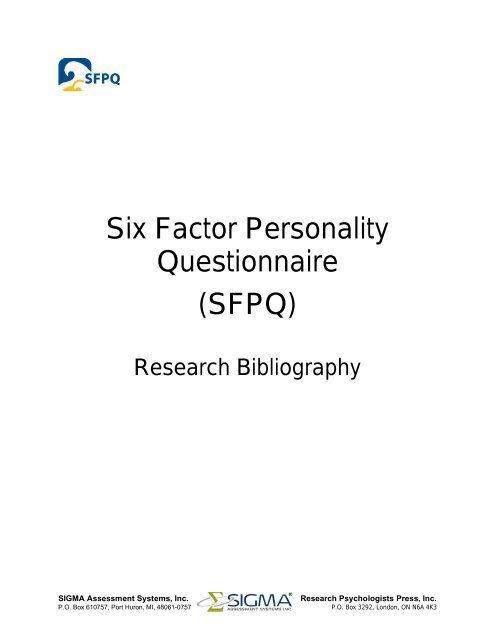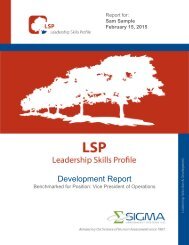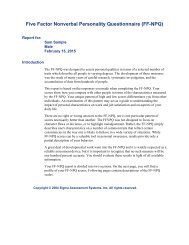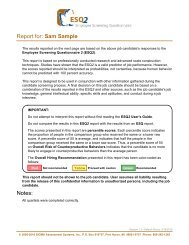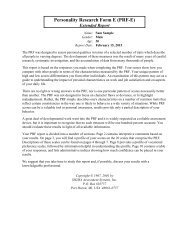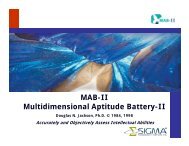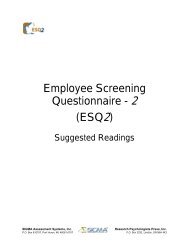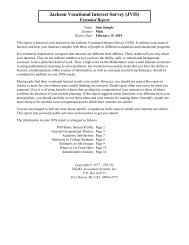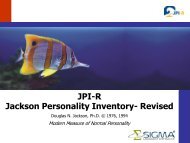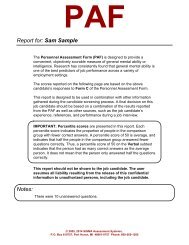Six Factor Personality Questionnaire (SFPQ) - Sigma Assessment ...
Six Factor Personality Questionnaire (SFPQ) - Sigma Assessment ...
Six Factor Personality Questionnaire (SFPQ) - Sigma Assessment ...
Create successful ePaper yourself
Turn your PDF publications into a flip-book with our unique Google optimized e-Paper software.
<strong>Six</strong> <strong>Factor</strong> <strong>Personality</strong><strong>Questionnaire</strong>(<strong>SFPQ</strong>)Research BibliographySIGMA <strong>Assessment</strong> Systems, Inc.P.O. Box 610757, Port Huron, MI, 48061-0757Research Psychologists Press, Inc.P.O. Box 3292, London, ON N6A 4K3
<strong>SFPQ</strong> Research BibliographyRESEARCH BIBLIOGRAPHY – <strong>SFPQ</strong> 1Bachelor, A., Meunier, G., Laverdiére, O., & Gamache, D. (2010). Client attachment to therapist:Relation to client personality and symptomatology, and their contributions to thetherapeutic alliance. Psychotherapy: Theory, Research, Practice, Training, 47(4), 454-468.Baruss, I., & Wammes, M. (2009). Characteristics of spontaneous musical imagery. Journal ofConsciousness Studies, 16(1), 37-61.Connelly, B. S., & Ones, D. S. (2010). An Other perspective on personality: Meta-analyticintegration of observers’ accuracy and predictive validity. Psychological Bulletin, 136(6),1092-1122.De Vries, R. E., & van Kampen, D. (2010). The HEXACO and 5DPT models of personality: Acomparison and their relationships with psychopathy, egoism, pretentiousness, immorality,and Machiavellianism. Journal of <strong>Personality</strong> Disorders, 24(2), 244-257.Dunn, A., & Eliot, J. (1996). Spatial intelligence and the <strong>Six</strong>-<strong>Factor</strong> <strong>Personality</strong> <strong>Questionnaire</strong>.Perceptual & Motor Skills, 82(3), 1235-1240.Fein, E. C., & Klein, H. J. (2011). <strong>Personality</strong> predictors of behavioral self-regulation: Linkingbehavioral self-regulation to five-factor model factors, facets, and a compound trait.International Journal of Selection and <strong>Assessment</strong>, 19(2), 132-144.Goldberg, L. R., Johnson, J. A., Eber, H. W., Hogan, R., Ashton, M. C., Cloninger, C. R., &Gough, H. G. (2006). The international personality item pool and the future of publicdomainpersonality measures. Journal of Research in <strong>Personality</strong>, 40(1), 84-96.Grist, C. L., Socha, A., & McCord, D. M. (2012). The M5-PS-35: A five-factor personalityquestionnaire for preschool children. Journal of <strong>Personality</strong> <strong>Assessment</strong>, 1-9.Grucza, R. A., & Goldberg, L. R. (2007). The comparative validity of 11 modern personalityinventories: Predictions of behavioral acts, informant reports, and clinical indicators. Journalof <strong>Personality</strong> <strong>Assessment</strong>, 89(2), 167-187.Hodson, G., & Sorrentino, R. M. (1999). Uncertainty orientation and the Big Five personalitystructure. Journal of Research in <strong>Personality</strong>, 33(2), 253-261.Hopwood, C. J., & Donnellan, M. B. (2010). How should the internal structure of personalityinventories be evaluated? <strong>Personality</strong> and Social Psychology Review, 14(3), 332-346.Hopwood, C. J., Wright, A. G., & Donnellan, M. B. (2011). Evaluating the evidence for the generalfactor of personality across multiple inventories. Journal of Research in <strong>Personality</strong>, 45(5),468-478.1Updated April 2012- 2 -
<strong>SFPQ</strong> Research BibliographyIliescu, D., Ilie, A., & Ispas, D. (2011). Examining the criterion-related validity of the EmployeeScreening <strong>Questionnaire</strong>: A three-sample investigation. International Journal of Selectionand <strong>Assessment</strong>, 19(2), 222-228.Insel, K., & Hsiao, C. (2004). Association of personality factors, cognitive function, and medicationadherence. The Gerontologist, 44(1), 51-53.Insel, K. C., Reminger, S. L., & Hsiao, C. (2006). The negative association of independentpersonality and medication adherence. Journal of Aging and Health, 18(3), 407.Jackson, D. N., Ashton, M. C., & Tomes, J. L. (1996). The six-factor model of personality: Facetsfrom the Big Five. <strong>Personality</strong> & Individual Differences, 21(3), 391-402.Jackson, D. N., Paunonen, S. V., Fraboni, M., & Goffin, R. D. (1996). A Five-<strong>Factor</strong> versus <strong>Six</strong>-<strong>Factor</strong> model of personality structure. <strong>Personality</strong> & Individual Differences, 20(1), 33-45.Jackson, D. N., & Tremblay, P. F. (2002). The six factor personality questionnaire. In B. deRaad, &M. Perugini, Big Five <strong>Assessment</strong> (pp. 354-372). Ashland, OH: Hogrefe & HuberPublishers.Loehlin, J. C. (2012). How general across inventories is a general factor of personality. Journal ofResearch in <strong>Personality</strong>, (in press).Maloney, P., Grawitch, M. J., & Barber, L. K. (2011). Strategic item selection to reduce surveylength: Reduction in validity? Consulting Psychology Journal: Practice and Research, 63(3),162-175.Markowitz, E. M., Goldberg, L. R., Ashton, M. C., & Lee, K. (2012). Profiling the “Proenvironmentalindividual”: A personality perspective. Journal of <strong>Personality</strong>, 80(1), 81-111.O’Neill, T. A., Goffin, R. D., & Gellatly, I. R. (2010). Test-taking motivation and personality testvalidity. Journal of Personnel Psychology, 9(3), 117-125.O’Neill, T. A., Goffin, R. D., & Gellatly, I. R. (2012). The knowledge, skill, and abilityrequirements for teamwork: Revisiting the Teamwork-KSA Test’s validity. InternationalJournal of Selection and <strong>Assessment</strong>, 20(1), 36-52.O’Neill, T. A., Goffin, R. D., & Gellatly, I. R. (2012). The use of random coefficient modeling forunderstanding and predicting job performance ratings: An application with field data.Organizational Research Methods, (in press).Powell, D. M., Goffin, R. D., & Gellatly, I. R. (2011). Gender differences in personality scores:Implications for differential hiring rates. <strong>Personality</strong> and Individual Differences, 50(1), 106-110.Saucier, G. (2003). An alternative multi-language structure for personality attributes. EuropeanJournal of <strong>Personality</strong>, 17(3), 179-205.- 3 -
<strong>SFPQ</strong> Research BibliographyTaormina, R. J. (2009). Social and personality correlates of gambling attitudes and behavior amongChinese residents of Macau. Journal of Social and Personal Relationships, 26(8), 1047-1071.Taormina, R. J., & Gao, J. H. (2010). A research model for Guanxi behavior: Antecedents,measures, and outcomes of Chinese social networking. Social Science Research, 39(6), 1195-1212.Tett, R. P., Freund, K. A., Christiansen, N. D., Fox, K. E., & Coaster, J. (2012). Faking on selfreportemotional intelligence and personality tests: Effects of faking opportunity, cognitiveability, and job type. <strong>Personality</strong> and Individual Differences, 52(2), 195-201.Tiliopoulos, N., Pallier, G., & Coxon, A. P. (2010). A circle of traits: A perceptual mapping of theNEO-PI-R. <strong>Personality</strong> and Individual Differences, 48(1), 34-39.Yusoff, M. S., Rahim, A. F., Aziz, R. A., Pa, M. N., Mey, S. C., Ja’afar, R., & Esa, A. R. (2011).The validity and reliability of the USM <strong>Personality</strong> Inventory (USMaP-i): Its use to identifypersonality of future medical students. International Medical Journal, 18(4), 283-287.- 4 -


